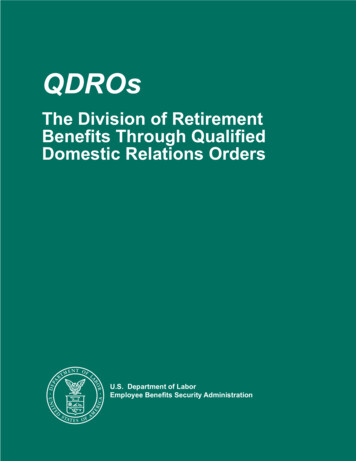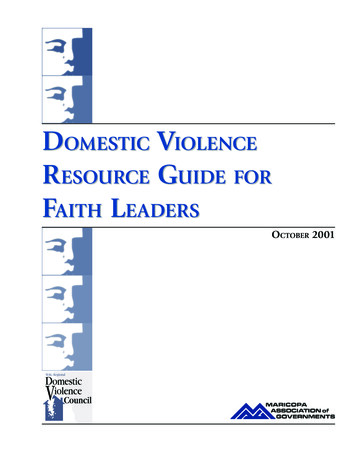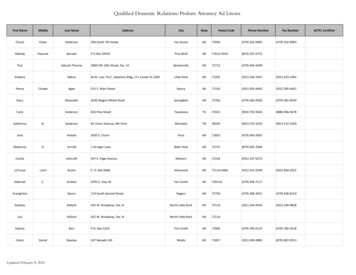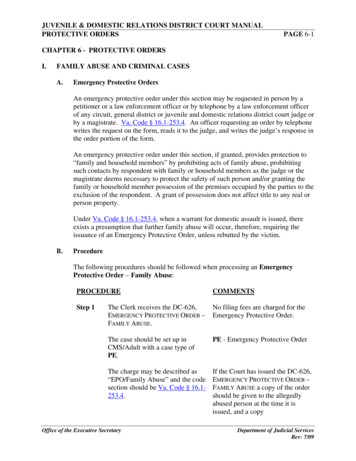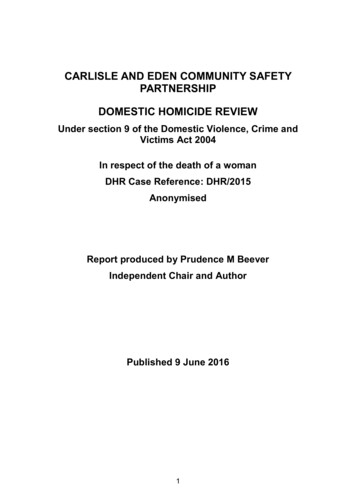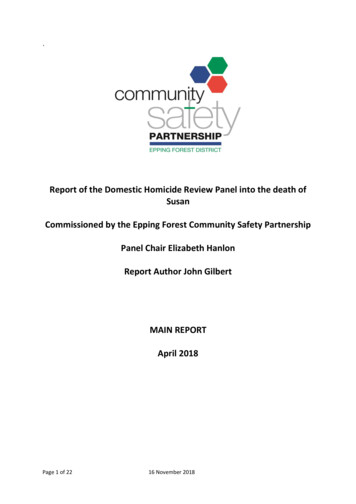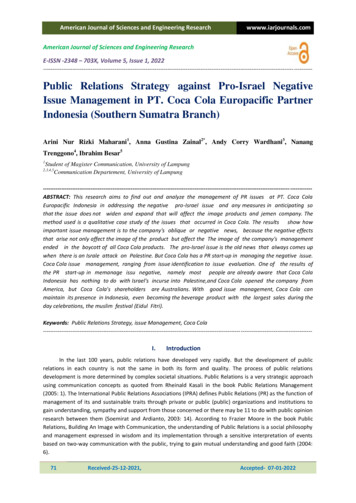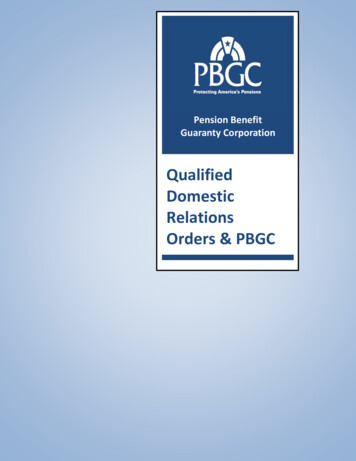
Transcription
Pension BenefitGuaranty CorporationQualifiedDomesticRelationsOrders & PBGC
This booklet provides general information to attorneys and other pension professionals on submittingdomestic relations orders to the Pension Benefit Guaranty Corporation (PBGC) after PBGC becomes trustee of aterminated pension plan. It also provides general information on the procedures PBGC follows to determine whetheran order is a qualified domestic relations order (QDRO) for purposes of paying benefits under Title IV of the EmployeeRetirement Security Act of 1974, as amended (ERISA). Under ERISA §206(d)(3)(G)(ii), each plan must establishreasonable procedures for determining whether an order is a QDRO, but plans may differ in the procedures theyestablish. The procedures described in this booklet are PBGC's procedures and may differ from procedures forplans that have not been trusteed by PBGC.The information summarizes PBGC's rules at the time that the booklet was published. It is not intended togive legal advice or to replace the advice of an attorney. None of this information takes precedence over legislation,regulations, or specific interpretations or rulings. The model orders and model language are provided solely to assistindividuals in preparing orders for submission to PBGC, and they cover only the most common situations that mayneed to be addressed in a domestic relations order. PBGC will not condition its determination of whether an orderis a QDRO on the use of any particular form or language.The information does not represent the government's interpretation of the rules governing QDROs.Interpretation of those rules is within the jurisdiction of the U.S. Department of Labor (DOL) and the InternalRevenue Service (IRS).This booklet may be obtained from PBGC's website at www.pbgc.gov or by calling PBGC at 1-800-400PBGC (7242). (TTY/TDD users may call the Federal Relay Service toll-free at 1-800-877-8339 and ask to beconnected to this number.)For additional information, DOL's publication The Division of Pensions through Qualified DomesticRelations Orders is available at www.dol.gov/ebsa/publications/qdros.html, or by calling the Employee BenefitsSecurity Administration Hotline at 1-866-444-EBSA (3272). IRS Notice 97-11 ("Providing Sample Language for aQualified Domestic Relations Order") was published January 13, 1997, at 1997-2 I.R.B. 49 and appears in its entiretyin Appendix C of DOL's QDRO publication.This edition of PBGC’s booklet Qualified Domestic Relations Orders & PBGC includes the followingchanges from the guidance published in September 2012: Modifies sections relating to separate interest orders to clarify how they are administered by PBGC. Clarifies how PBGC apportions adjustments required by ERISA’s legal limitations on benefits between analternate payee and a participant covered by a QDRO.Required Paperwork Reduction Act NoticeUnder ERISA, no part of an individual's benefit under a plan trusteed by PBGC may be assigned to another personinvolved in a domestic relations proceeding, such as a separation or divorce, unless PBGC receives a domesticrelations order and determines it to be a qualified domestic relations order, or "QDRO." The model QDROs andaccompanying guidance in PBGC's booklet, Qualified Domestic Relations Orders & PBGC, are intended to assistparties by making it easier to comply with statutory requirements. Under the Paperwork Reduction Act, an agency maynot conduct or sponsor, and a person is not required to respond to, a collection of information unless it displays acurrently valid OMB control number. This collection of information has been approved by the Office of Managementand Budget (OMB) under control number 1212-0054 (expires 12/31/2018). The information provided to PBGC may bedisclosable under the Freedom of Information Act and the Privacy Act.PBGC estimates that the average burden of preparing a QDRO with the assistance of PBGC's booklet will be 3/4hour of the participant's or alternate payee's time and 478 in professional fees if the participant or alternate payeehires an attorney or other professional to prepare the QDRO, or 10 hours of the participant's or alternate payee's timeif they prepare the QDRO without hiring an attorney or other professional. Comments concerning the accuracy of thisestimate or suggestions for further reducing this burden may be sent to Pension Benefit Guaranty Corporation, Officeof General Counsel, 1200 K Street NW, Washington, DC 20005-4026.
ContentsPageIQualified Domestic Relations Orders and PBGC2IIPBGC Model QDROs:4PBGC Model Separate Interest QDRO [PDF]5PBGC Model Shared Payment QDRO [PDF]9PBGC Model QDRO Instructions13Section 1. Identification of Plan13Section 2. Identification of Participant and Alternate Payee13Section 3. Amount of Benefit to Be Paid to the Alternate Payee13Section 4. PBGC Benefit Adjustments16Section 5. Benefits Start17Section 6. Form of Benefit18Section 7. Benefits Stop19Section 8. Death of Participant20Section 9. Death of Alternate Payee20Section 10. Surviving Spouse Rights of Alternate Payee21Section 11. Other Requirements24Section 12. Reservation of Jurisdiction24IIIProcedures and Checklist25Appendix ADefined Benefit Pension Plans and PBGC Benefit Rules30Appendix BDomestic Relations Orders Qualified Before PBGC Becomes Trustee33Appendix CQDRO Tax Rules34Appendix DPBGC Model Child Support Shared Payment QDRO35Appendix EPBGC Model Treat-As-Spouse QDRO40Appendix FLanguage for Including a Contingent Alternate Payee47Appendix GLanguage for Including Subsidized Early Retirement Benefits ina Separate Interest QDRO49How to Obtain Certain Participant Information from PBGC50Appendix HGlossary511
I. Qualified Domestic Relations Orders and PBGCThePensionBenefitGuarantyCorporation (PBGC) is a federal agency thatinsures the benefits of about 41 million menand women in more than 24,000 privatesector defined benefit pension plans. Adefined benefit pension plan that does nothave enough money to pay benefits may beterminated if the employer responsible for theplan faces severe financial difficulty, such asbankruptcy, and is unable to maintain theplan. In such an event, PBGC becomestrustee of the plan and pays pension benefits,subject to legal limits, to plan participantsand beneficiaries. PBGC's rules on benefitamounts and benefit forms payable by PBGCare summarized in Defined Benefit PensionPlans and PBGC Benefit Rules – AppendixA.PBGC reviews a domestic relations orderthat has been submitted to PBGC and mustdetermine that the order is qualified beforebeing able to pay benefits to an alternatepayee.PBGC QDRO RequirementsIdentity of the plan participant, eachalternate payee, and each pension plan. AQDRO must specify the name and last knownmailing address of the plan participant andeach alternate payee covered by the order. AQDRO also must identify the name of eachplan to which the order applies; this shouldbe each plan's formal name.Amount to be paid and when paymentsstart. A QDRO must state how much of theplan participant's benefit is to be paid to thealternate payee, such as a dollar amount orpercentage of the benefit, or make clear themanner in which the amount is to bedetermined. A QDRO also must specify orallow the alternate payee to choose whenpayments to the alternate payee will start.The benefits of a pension plan participantgenerally may not be assigned or alienated.The law provides an exception for domesticrelations orders that relate to child support,alimony payments, or marital property rightsof an alternate payee (a spouse, formerspouse, child, or other dependent of a planparticipant). The exception applies only if thedomestic relations order meets specific legalrequirements and the plan administratordetermines that it is qualified, that is, aqualified domestic relations order, or"QDRO." See section 206(d) of ERISA andrelated regulations, and section 414(p) of theInternal Revenue Code of 1986, as amended(Code).What happens on the death of the planparticipant and the alternate payee. AQDRO should specify whether the alternatepayee will be treated as the participant'sspouse for purposes of any survivor benefits.A QDRO also should specify what happensto benefits when the participant or alternatepayee dies.2
What a QDRO Must Not RequireA QDRO must not require PBGC to: pay any benefits not permitted underERISA or the Code; provide any type or form of benefit, orany option, not otherwise provided underthe plan or paid by PBGC; pay benefits with a value in excess of thevalue of benefits that would otherwise bepayable by PBGC; pay benefits to an alternate payee whenthose benefits are required to be paid toanother alternate payee under an orderpreviously determined to be a QDRO; pay benefits to the alternate payee for anyperiod before PBGC receives the order; pay benefits as a separate interest to thealternate payee if the participant isalready receiving benefit payments; or change the benefit form or beneficiary ofa joint-life annuity if the participant isalready receiving benefit payments.3
II. PBGC Model QDROsPBGC has developed two model QDROsfor general use after a defined benefit planhas terminated and PBGC has become trusteeof the plan: a PBGC Model Separate InterestQDRO and a PBGC Model Shared PaymentQDRO. (Two additional model QDROs thatmay be used specifically for child support orfor providing only a surviving spouse benefitare located in Appendices D and E,respectively.) A QDRO should be clear as towhether the alternate payee is to receive aportion of the actual benefit payments madeto the participant (a shared payment order) orthe value of a separate portion of theparticipant's retirement benefit, where thebenefit may be paid at a time and in a formdifferent from that chosen by the participant(a separate interest order). PBGC's ModelQDROs make this distinction clear.(2) receive pension benefits over his or herlifetime rather than the participant's lifetime,and (3) choose a straight life annuity orcertain-and-continuous (C&C) annuity thatmay provide benefits to the alternate payee'sbeneficiary for a limited period. The QDROmay also assign survivor benefits to thealternate payee, but this assignment is notneeded to ensure that the alternate payeereceives benefits for life (see page 21).The PBGC Model Shared PaymentQDRO may be used where the planparticipant and the alternate payee will"share" each benefit payment. The modelmay be used regardless of whether theparticipant has started receiving benefits ornot. However, the alternate payee cannotbegin receiving benefits before theparticipant does. The PBGC Model SharedPayment QDRO must specify the amount orpercentage of the participant's benefitpayment that is assigned to the alternatepayee and the number or duration ofpayments to the alternate payee. Payments tothe alternate payee stop, at the latest, whenthe participant dies or stops receivingpayments. However, the QDRO may alsoassign the alternate payee a right to survivorbenefits or other benefits under the plan.The PBGC Model Separate InterestQDRO may be used only if theparticipant's benefit payments have notstarted when the domestic relations orderis submitted to PBGC for qualification.The participant's benefit is divided into twoseparate parts, with each part providing theparticipant and the alternate payee with his orher separate interest in a lifetime annuity.Unlike the PBGC Model Shared PaymentQDRO (see below), the PBGC ModelSeparate Interest QDRO gives the alternatepayee control over the timing and form of hisor her benefit payments. The alternate payeemay (1) start his or her payments before theparticipant (subject to certain restrictions),4 PBGC ModelQDRO [PDF]SeparateInterest PBGC ModelQDRO [PDF]SharedPayment
PBGC Model Separate Interest QDRO(You may use this model when a defined benefit pension plan has terminated, PBGC hasbecome trustee of the plan, and the parties want PBGC to divide the value of the participant’sbenefit between the participant and the alternate payee. You may use this model only if theparticipant’s benefit payments have not started when the order is submitted to PBGC forqualification. Please read instructions for important information.)[applicableapplicable state domestic relations law citationscitations][formal name of plan]5
[Name of the Participant][address][Social Security Number][Name of the Alternate Payee][address]Security Number][Social6
Language for Including a Contingent Alternate Payee – Appendix F)(see[NOTE: Section 10 applies only if the Alternate Payee is the spouse or former spouse of the Participant; itdoes not apply if the Alternate Payee is a child or other dependent of the Participant.][NOTE: Once a separate interest is qualified, the Alternate Payee’s rights to benefits for life areguaranteed. In light of this, survivor benefits need not be provided in a separate interest order to ensure7
that the Alternate Payee continues to receive benefits after the Participant’s death. See page 21 foradditional information on surviving spouse rights in separate interest orders. However, if the parties desirethat an additional amount be payable to the Alternate Payee at the Participant’s death, one or both of thefollowing provisions may be included. The survivor benefit in this case will be based on the benefit inwhich the Participant retains a separate interest, not on the entire Participant benefit before it was dividedinto two separate parts.][NOTE: When “X%” is used above, it refers to the portion of the survivor benefit awarded to theAlternate Payee – not the automatic survivor percentage of the plan's QJSA or QPSA (which is typically50%). Thus, if the Alternate Payee is awarded 40% of the QPSA benefit and the plan's automatic survivorpercentage for the QPSA is 50%, then the Alternate Payee will receive 20% of the Participant's benefit ashis/her survivor benefit.]8
PBGC Model Shared Payment QDRO(You may use this model when a defined benefit pension plan has terminated, PBGC has becometrustee of the plan, and PBGC is to pay the alternate payee a portion of the participant’s monthlybenefit payments. You may use this model either before or after the participant’s benefitpayments have started; however, benefit payments to the alternate payee cannot start untilthe participant’s benefit payments have started. Please read instructions for importantinformation.)[applicable state domestic relations law citations][formal name of plan]9
[Name of the Participant][address][Social Security Number][Name of the Alternate Payee][address]Security Number]spouse/child/other dependent][spouse/former[Social[insert future event]another future date. This date must bethe first day of a month10
[insertspecific event]Alternate Payee – Appendix F)(see Language for Including a Contingent[NOTE: Section 10 applies only if the Alternate Payee is the spouse or former spouse of the Participant; itdoes not apply if the Alternate Payee is a child or other dependent of the Participant.][NOTE: Survivor benefit may be assigned to the Alternate Payee only if the Participant is not alreadyreceiving benefits or if when the Participant began receiving benefits the benefit was being paid as a jointand survivor benefit with the Alternate Payee as survivor.]OR11
OR[NOTE: When “X%” is used above, it refers to the portion of the survivor benefit awarded to theAlternate Payee – not the automatic survivor percentage of the plan's QJSA or QPSA (which is typically50%). Thus, if the Alternate Payee is awarded 40% of the QPSA benefit and the plan's automatic survivorpercentage for the QPSA is 50%, then the Alternate Payee will receive 20% of the Participant's benefit ashis/her survivor benefit.]12
PBGC Model QDRO InstructionsThe following information on completing the PBGC Model Separate Interest QDRO andModel Shared Payment QDRO discusses each provision separately, but all of the provisions worktogether. The time that benefit payments start and stop can affect the amount of benefits theparticipant and the alternate payee will receive. Similarly, the form of benefit payments – whetherbenefits are paid as a straight life annuity or an annuity with survivor benefits – can affect theamount of benefits the parties will receive.The models are drafted assuming one plan and one alternate payee. If the domestic relationsorder (Order) is intended to cover more than one PBGC-trusteed plan or more than one alternatepayee, the Order should be clear as to which plan and alternate payee each provision is addressing.The preferred way of doing this is to repeat sections 1 through 10 as necessary for each plan.an alternate payee is a minor or legallyincompetent, the Order must include thename and address of the guardian, other legalrepresentative, or state agency to whomPBGC will send payments on behalf of theminor or legally incompetent person (seelanguage in section 2.b. of the PBGC ModelChild Support Shared Payment QDRO –Appendix D).Introductory ParagraphInsert the applicable state domesticrelations law citations.Section 1. Identification of PlanInsert the formal name of the plancovered by this Order (i.e., the full name asstated in plan documents). PBGC willdetermine whether an order is qualified onlyfor plans specifically named and for whichPBGC is the trustee. If the participantparticipated in more than one pension plan,the parties are responsible for ensuring thateach plan subject to the order is properlyidentified.Section 3. Amount of Benefit to BePaid to Alternate PayeeInsert the flat dollar amount orpercentage of the participant's benefit thatthe alternate payee is to receive. Also insertthe date as of which the benefit is to bedetermined, if applicable.Section 2. Identification ofParticipant and Alternate PayeeThe Order must specify how much of theparticipant's benefit the alternate payee willreceive. Because the participant often doesnot know the specific amount that will bepaid at retirement, this can be difficult for theOrder to address and for PBGC to interpret.The assistance of an actuary may be helpfulin making these complex determinations.Information about the participant's benefitunder a plan trusteed by PBGC may beobtained by a prospective alternate payee (orhis or her guardian) by requesting thisinformation from PBGC (see How to Obtain(a) Insert the name, mailing address andSocial Security Number of the participant.(b) Insert the name, mailing address andSocial Security Number of the rspouse/child/otherdependent) of the alternate payee to theparticipant.The Order should be clear on the identityof the participant and the alternate payee. If13
Certain Participant InformationPBGC – Appendix H).fromexample, 50% of the participant’s benefit).An order may also assign a specific dollaramount payable to the alternate payee.PBGC has found there is less confusionwith an Order that states a specific percentageof the benefit (for Separate Interest QDROs)or specific percentage or dollar amount of themonthly benefit (for Shared PaymentQDROs), and the models are drafted withthat approach. If, instead, the parties chooseto include a formula, PBGC will treat thedomestic relations order as qualified only ifit can determine the benefit under the formulabased on the information in the Order. TheOrder must include any information thatwould be necessary to determine the benefitassigned and, where applicable, the periodduring which it is to be paid (for example, achild's birth date if the benefit stops when thechild attains a certain age).However, when a separate interest orderassigns a specified dollar amount to analternate payee and benefit adjustments aresubsequently necessary, the effect of thebenefit adjustment on the amountsapportioned to each party may result in theparties receiving benefits that wereunintended by the parties. The number offactors that go into the calculation of theparticipant’s and alternate payee’s benefitsunder a separate interest order (including theplan's early retirement factors (if applicable),the ages of the participant and alternate payeeat the time the alternate payee's benefitpayments begin; and the form elected by thealternate payee) may make it difficult toknow what each party will receive if aspecified dollar amount is assigned and needsto be adjusted. See Section 4 – PBGC BenefitAdjustments.Neither type of Order can provide forpayments to the alternate payee to be payableas of a date before PBGC receives thedomestic relations order, but the SharedPayment QDRO can increase the monthlypayment amount to the alternate payee (anddecrease the monthly payment to theparticipant by the same amount) for aspecified period.NOTE: In a separate interest QDRO, thesum of the values of the participant’s portionand the alternate payee’s portion cannotexceed the total value of the benefit PBGCwould have paid the participant assumingthere was no Order.There are many ways an Order canspecify the portion or value of a benefit orpension payment that the alternate payee is toreceive under the Order.The PBGC Model Shared PaymentQDRO provides that the alternate payee willreceive a portion of each of the participant'sbenefit payments on or after the date theparticipant starts benefit payments. It allowsthe alternate payee's portion to increase ordecrease at a specified time or upon aspecified event. The Order must specify theamount and timing of any change.NOTE: The dollar amount or percentagecan be based on the participant's entirebenefit or payment, or just on the part of thebenefit or payment earned during themarriage and/or up to a specified date.The PBGC Model Separate InterestQDRO provides that the alternate payee willreceive a benefit that is the actuarialequivalent of a specified portion of thebenefit that the participant has earned as of agiven date (see below), typically as apercentage of the participant’s benefit (forNOTE: In a Shared Payment QDRO, thesum of the portions paid to the participantand to the alternate payee cannot exceed thetotal payment that PBGC would have paidthe participant assuming there was no Order.14
A Separate Interest QDRO must specifythe date as of which the alternate payee'sportion of the participant's benefit is to bedetermined. Typically, for domestic relationsorders issued after PBGC trustees a plan, thedivision of benefits is based on theparticipant's benefit as of the date: of maritalseparation, of divorce, or of plan termination(in plans trusteed by PBGC, all benefitaccruals will have ceased no later than thedate the plan terminated). The choice of thedetermination date (for example, at the dateof marital separation or divorce) can have asignificant effect on the benefit amountassigned to the alternate payee and the benefitamount retained by the participant.20 years of service. Some plans actuariallyreduce the early retirement benefit to reflectthe longer payout-for example, if the benefitwould be 1,000 per month starting at age 65,it might be reduced to 650 per monthstarting at age 60.Other plans may not reduce the benefit atall-for example, paying the same 1,000 permonth starting at age 60 as the participantwould receive starting at age 65. This kind ofearly retirement benefit is referred to as a"fully-subsidized" early retirement benefit,because the participant's benefit is notreduced even though it will cost the planmore due to the earlier starting date. (Thebenefit would be considered "partiallysubsidized" if the benefit were reduced, butnot as much as would be necessary to make itequal in value to the benefit that would bepaid starting at age 65.)Example 1 – Separate Interest QDRO.Carol is the plan participant and is age 40;Mark is age 35. Their QDRO provides thatMark will receive a separate interest that isactuarially equivalent to 50% of Carol'spension benefit at date of divorce. Carol'sbenefit in the form of a straight life annuitywith payments beginning at her age 65 is 600 per month. Mark's 50% interest inCarol's benefit has a value that is actuariallyequivalent to a life annuity of 300 ( 600 x50%) per month to Carol beginning at herage 65.A Separate Interest QDRO may bewritten so as to provide (or not provide) thealternate payee with all or part of the value ofany subsidized early retirement benefit underthe plan. If the participant has notcommenced receiving the subsidized benefitby the time an alternate payee has elected tocommence benefits under a Separate InterestQDRO, the alternate payee cannot receive aportion of the subsidized early retirementbenefit when his or her benefit commences.However, the Order may provide that if andwhen the participant begins receiving asubsidized early retirement benefit, a portionof the early retirement subsidy will beprovided to the alternate payee. SeeLanguage for Including Subsidized EarlyRetirement Benefits in a Separate InterestQDRO – Appendix G.Mark is younger than Carol, so a benefit of 300 per month to Carol at age 65 generallywill provide a different monthly benefit forMark depending upon when he starts. Mark'sactual monthly life annuity payments willdepend on his age when he starts benefitpayments, actuarial factors, and the benefitform he elects.Most pension plans provide for "normalretirement" at age 65 (or, if later, the fifthanniversary of the date the participantcommenced participation under the plan).Many plans allow "early retirement" at someyounger age, often in combination with aspecified amount of service with theemployer-for example, at age 60 with at leastNOTE: if the Order is silent with respectto whether the alternate payee is to receiveany portion of the subsidized early retirementbenefit, PBGC will pay the entire subsidy tothe participant.15
Under the PBGC Model Shared PaymentQDRO, if the alternate payee receives apercentage share of the participant's y include a portion of the earlyretirement subsidy if the participant retiresearly.This method of allocating the benefit issometimes referred to as the marital portionor marital fraction method, and it can be usedfor both shared payment and separate interestQDROs.NOTE: if this method is used, the partiesshould carefully check the formula foraccuracy and to confirm that it provides thebenefits they intend, especially if the orderstates the number of months. For example, ifPBGC’s records indicate that the participantearned benefits under the plan for 126months and the order uses 100 months,PBGC may disqualify the order or seekclarification from the parties.The PBGC Model Shared PaymentQDRO provides that a specific amount or apercentage of each of the participant'smonthly benefit payments is paid directly tothe alternate payee (for example, 400 permonth, or 25% of each monthly benefitpayment). The combined benefit payments tothe participant and the alternate payee undera Shared Payment QDRO equal the benefitthat would be paid to the participantassuming there was no QDRO.Example 3 – Marital Fraction Method(Separate Interest QDRO).Continuing with Example 1, assume Carolearned benefits under the plan for 10 yearsand was married to Mark for 5 of those years.If their QDRO applied the marital fractionmethod to Mark's 50% separate interest,Mark's 50% interest would be multiplied bythe marital fraction of 5/10. Thus, Mark'spension would be actuarially equivalent tothe value of a straight life annuity of 150( 600 x 50% x 5/10) per month payable toCarol beginning at her age 65. (If Mark andCarol had been married 12 years, and Carolhad earned benefits for 10 of those years, themarriage fraction would have been 10/10, or1. Mark would receive a benefit actuariallyequivalent to 50% of Carol's benefit.)Example 2 – Shared Payment QDRO.A QDRO provides Dick's former spouse,Jane, with 25% of each of his monthlypension payments once his payments start.Dick begins receiving his benefits at age 65,and his monthly payments are 900 permonth in the form of a straight life annuity.Jane's portion of Dick's payment will be 225per month ( 900 x 25% 225). Under theQDRO, Jane will receive 225 per month forDick's lifetime and Dick will receive 675 permonth ( 900 – 225).In calculating the amount or percentageto be given to the alternate payee under aQDRO, the parties frequently will take intoaccount the portion of the participant'sbenefit that was earned during the time thealternate payee and the participant weremarried. Under this method, the alternatepayee's portion of the participant's benefit(for example, 50%) would be multiplied by afraction, the numerator of which is thenumber of months that the participant earnedbenefits under the plan during the parties'marriage, and the denominator of which isthe total number of months that theparticipant earned benefits under the plan.Section 4. PBGC Benefit AdjustmentsInsert the method for apportioning anyadjustments PBGC makes in benefits.Because the parties may wish to handlebenefit increases and decreases differently,the models include separate sentences foreach.After trusteeing a plan, PBGC mayreduce benefits as necessary to meet thelimitations established by ERISA (see16
Defined Benefit Pension Plans and PBGCBenefit Rules – Appendix A). PBGC paysestimated benefits until it has completed itswork on the plan and determined finalbenefits. In some cases-especially in planswith benefits that exceed PBGC guaranteelimits or that have complex benefitstructures-final benefit amounts will differfrom the estimated payment amounts paid byPBGC.will actuarially reflect the benefitcommencement date, duration of the benefitpayments, the elected benefit form, etc.If a QDRO awards a fixed-dollar amountof the participant's benefit to the alternatepayee with no additional guidance, PBGCwill first increase or decrease the participant'sbenefit to reflect PBGC's adjustment. PBGCwill not adjust the fixed-dollar amountawarded to the alternate payee for anincrease, and will reduce the alternate payee'sfixed-dollar am
an order is a qualified domestic relations order (QDRO) for purposes of paying benefits under Title IV of the Employee Retirement Security Act of 1974, as amended (ERISA). Under ERISA §206(d)(3)(G)(ii), each plan must establish reasonable procedures for determining whether an order is a QDRO, but plans may differ in the procedures they establish.
